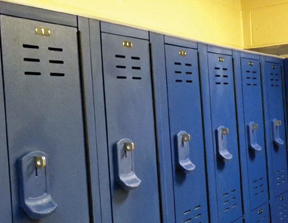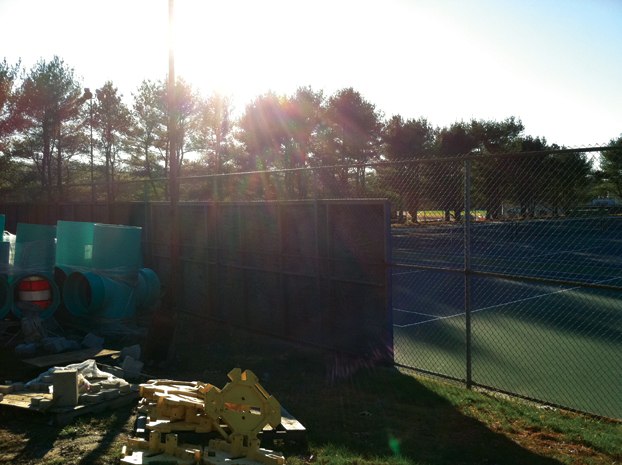Overseeing A Major Facilities Renovation
A Season On The Road
While the main stadium looks pristine now with its impressive field, bright blue bleachers and new press box, the students price for this renovation, as well as what was occurring inside the high school, was to spend the fall season on the road. For the seniors, this meant no home games during the final months of their careers.
It was a mess, Sousa says with a roll of the eyes. We basically had to shuffle everyone around. Athletic director David Sousa says the previous lockers at Waterford were easy to break intothe new ones are sturdier and cannot be manipulated. Athletic director David Sousa says the previous lockers at Waterford were easy to break intothe new ones are sturdier and cannot be manipulated. |
 The tennis courts are not going to be affected by the renovations at Waterford…except for the pileup of building materials stored to the side. The tennis courts are not going to be affected by the renovations at Waterford…except for the pileup of building materials stored to the side. |
This is how Sousa handled each sport to ensure they played a full season, albeit away from the confines of Waterford:
Football The team played 10 road games and one home game hosted by the Coast Guard Academy, which is located three to four miles from Waterford. The Coast Guard offered their field for free and provided a great environment for this group of road warriors.
It was our seventh game and we needed something, Sousa says. It really helped us out a lot.
Despite the inconvenience, the squad qualified for the state tournament for the first time in eight years.
The players just understoodwere getting on a bus on Friday, we’re going someplace where they have grass and lines, and we’re going to play, Sousa says while crediting his football coach, Mike Ellis, for keeping the team motivated.
Swim The team had to compete at the University of Connecticut-Avery Point in Groton, which is about 8 miles from Waterford. Fitch High Schools athletic department, adjacent to Waterford (separated by a bridge), allowed the Lancer swimmers to practice with their school.
That was a nice gesture. We had different communities helping out, Sousa remarks.
Cheer Practiced at the middle school.
Boys And Girls Soccer They were shuttled to the in-town soccer facility.
Field Hockey This is the only sport that played on campus but still had to deal with adversity as that team plays on the baseball field, but due to construction, the space was not as good as it normally is.
For the athletic department, it squeezed an already tight budget close to the breaking point as Sousa now had to plan for more buses and travel expenses. On the positive side, Sousa knew this was coming, so he had ample time to plan for the additional costs. He did note, however, when you are used to spending money for five away football games while running two buses at a time, and then you have twice as many, the costs jump quickly.
For the swim team, the school paid to shuttle the athletes to Avery Point, then the parents picked up when practice or an event concluded. A saving grace was that the schools bus contract allowed for extra transport within the town (middle school or the in-town soccer facility) at no additional cost.
|
The Hidden Aspects Of A Major Renovation When planning for a major athletic-facility renovation, athletic directors are forced to learn all they can about turf, seating, scoreboards, flooring, lighting, sound systems, storage units, track surfaces, locker rooms and so much more. But, how many athletic directors consider how closely they must work with their moving companies? Waterford High School (Conn.) athletic director David Sousa says what seems like a small detail can become a major issue during renovations. He never gave much thought to the moving company and having so much of his athletic stuff (for lack of a better term) packed away. The moving company said hed have access to his materials in September. Sousa says November rolled around and things still were scattered about in various storage units. There was'nt an exact inventory of where items were located, which threw Sousas already-tight schedule into a tailspin when attempting to track down certain items. Sousa says his team plays for a soccer cup with a neighboring school every year. Waterford had won it the year prior but once the athletics renovations started, the cup ended up in storagesomewhere. Waterford lost the cup match this season with the cup hidden somewhere on campus. Sousa says he spent a good amount of time sifting through storage materials to dig up the cup. Along the same lines, Waterford and East Lyme play a traditional New England rivalry football game on Thanksgiving. Separated by a bridge, the towns compete for the Battle of the Bridge trophy, which is made from actual materials used in the construction of the bridge. To avoid public embarrassment for Waterford, Sousa once again had to delve deep into the storage units to look for the trophy. My advice: Be active in the packing of your materials when they need to be in storage for awhile, Sousa says. You don’t want to spend hours looking for a single thing you need when the time comes. |
On a much lesser scale, Sousa has spent his fall season on the road as well. Once housed in a roomy office with a couple of windows, Sousa has been relegated to a basement spot surrounded by too-close walls made of concrete. Hes now separated from the main hub of the high school and coaches must go out of their way to get to his office, which appears to be more of a storage unit than a space fit for the athletic director.
Sousa says hes not letting it bother him as he knows another move is in the works once the school construction is done. He adds it would be hypocritical of him to sit there and complain about moving his office while his athletes are jumping on buses simply to go to practice.
Finalizing Part Of The Project
Having the entire fall sports program on the road posed a major hurdle for Sousa and the athletic department, but when dealing with a large-scale project such as this renovation, it was'nt the only headache encountered.
Sousa says he never felt pressure from students or parents about the lack of a home field for the fall sports season except for when the stadium was'nt ready for the big Thanksgiving Day rivalry game with East Lyme (high schools in New England play their primary football rival on Thanksgiving Day, which typically leads to big crowds and large gate receipts).
Originally, the plan was for the football stadium to be ready for the game. The field was in place. The bleachers were ready. The press box was set. But, the stadium was still considered a construction zone, which made it unfit to be filled with thousands of fans.
When the field got close and you could see how beautiful it was, the football players wanted to be out there, Sousa says. I was a football coach here for 10 years and I understood that. But, the last four or five days, we let them practice out there and it was a great experience for them. They got to be the first ones on the field.
With the Thanksgiving Day deadline not a reality, Sousa says the expectation is that some spring sports (namely boys and girls lacrosse) will be on the field this year. By then, the scoreboard will be up and ready, as well as all the lighting. The lighting plays a key role in the usefulness of the stadium for players and parents moving forward.
Well go from daytime games to mostly nighttime games, which is big for the parents, Sousa says. Now, they can work all day and come watch their kids without having to get out early.
The track teams, on the other hand, are a different matter completely as the new eight-lane track cannot be completed for at least another 18 months. Due to being part of the larger new-school project, the track is slated to run directly into the path of the existing school. The old school is not going to be demolished until 2013, which means the track cannot be finalized until then.
Sousa says, we expect to be in the pool any day, during the November interview. It’s a completely renovated pool with new lighting, sound systems, lockers and bleachers. The pool portion of the project originally was scheduled to be completed sooner (to allow the boys swim team to start the season practicing in there) but it didn’t quite work out as planned. Sousa says hes finding this is typical of a large-scale renovation.
Stress Specifics
Sousa says hes never been a part of a major renovation like what is taking place at Waterford. Thirteen years ago, when he was working at the Bacon Academy (Colchester, Conn.), that institution built a new school but his input was more limited to the locker room rather than the overall project.
After going through the process, Sousa says his advice is to be more specific when working with the construction companies, planners, architects and whoever else has a direct hand in building on your campus.
 The athletic renovations are part of a $60 million new-school project (part of the new school is pictured) in Waterford, Conn.
The athletic renovations are part of a $60 million new-school project (part of the new school is pictured) in Waterford, Conn.
As an example, Sousa says he requested some storage area outside of the main stadium behind the bleachers. Whats being built are 10-by-20-foot units, but he was thinking more like 40-by-60-foot areas to house some weightlifting and team meetings. Plus, he adds, follow-up is critical.
When you say things, you have to follow up on them, Sousa cautions others about to embark on a major renovation project at their school.
You think they know what you are looking for, then all of the sudden, it’s six weeks later and it’s way different than you thought it was going to be. Unfortunately, sometimes it becomes a money issue.
Those money issues boil down to the building committee overseeing the project. If that committee makes a decision based on what that group of people (with some athletic input) believes is more important and deserves more money, then you have to adapt.
Theres a bottom line. You have to give and take, and you have to realize what is important, Sousa adds. That (the stadium) was going to be our jewel, so we wanted to make sure it looks good and is very efficient for us.





